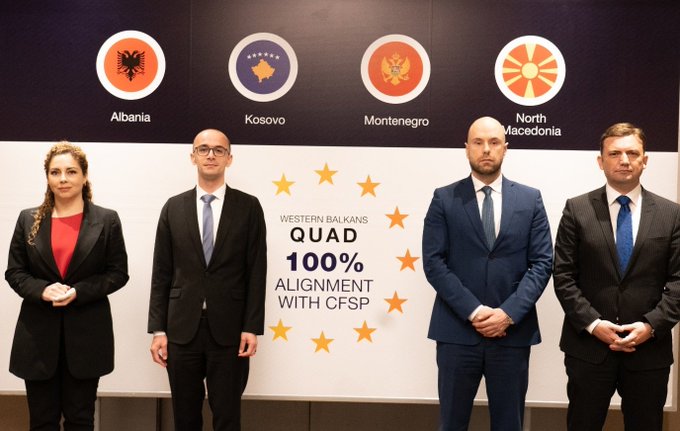BRUSSELS BEHIND THE SCENES
Weekly analysis with Sam Morgan
Countries need to band together in order to get big things done. But where do you draw the line? Is being in more than one union a boon or counterproductive? The Balkans stoked that debate this week.
Last month, every Brussels expat’s favourite football team, Union Saint-Gilloise, played German capital club Union Berlin in what was a battle of the unions. Trade unions have taken to the streets in recent weeks to demand better working conditions as well.
In Europe these days, throw a stone in any direction and you will hit a union of some sort. Even the European Union’s prospective members are teaming up to form their own mini unions.
But is this too much of a good thing?
BRUSSELS BEHIND THE SCENES includes weekly analysis not found anywhere else, as Sam Morgan helps you make sense of what is happening in Brussels. If you want to receive Brussels Behind the Scenes straight to your inbox every week, subscribe to the newsletter here.
The European Union is the hottest club in town, even if NATO membership has dominated headlines in recent months. Finland is on the cusp of joining, after Hungary and Türkiye finally stopped messing around, while Sweden still has some way to go.
NATO makes sense partly because it has the United States and United Kingdom, two nuclear-armed nations, as members. It co-exists quite nicely with the EU, even though the Brussels-based bloc has its own defence and security policies and ambitions.
The European Economic Area (EEA) and European Free Trade Association (EFTA) also fit in, somehow, although they look increasingly anachronistic with each passing year.
Further enlargement of either NATO or the EU looks unlikely anytime soon, given Ukraine’s delicate position and the almost total lack of appetite among existing EU nations to welcome new members until internal reform is completed.
With little chance of even that happening and conscious that Brussels must compete with Moscow and Beijing for influence in its own backyard, EU leaders launched the European Political Community last year in a bid to keep interested parties sweet.
Another union of sorts that has to contend for bandwidth with more established unions.
All of the enlargement contenders, the Eastern Partnership countries and even the UK attended the first EPC summit and the next edition is pencilled in for June with Moldova hosting proceedings.
But the ultimate aims of this new union are still rather vague. It is very much not a launchpad toward full EU membership but neither is it a totally separate entity. So this summer’s meeting will have to shed some more light on what its members actually want from it.
Balkans-bound
“The EU will never be complete without the Western Balkans,” is the obligatory soundbite that European leaders utter whenever broaching the subject of admitting Bosnia, Montenegro, Serbia et al but it is yet to be proven anything other than empty words.
Fed up of waiting and jumping through hoops, Albania, North Macedonia and Serbia launched the long-talked-about Open Balkans initiative in 2021 and have since signed a couple of agreements pledging closer cooperation on various matters.
Informally known as ‘mini-Schengen’, the initiative is meant to improve economic conditions within its members and boost exchange of workers and students, ideally increasing their chances of fulfilling the EU’s accession criteria.
Bosnia, Kosovo and Montenegro have expressed varying degrees of interest in joining; however, political realities in each mean that it is unlikely any of the three will sign up anytime soon.
In addition, as of this week there is also the Western Balkan Quad forum, made up of Albania, Kosovo, Montenegro and North Macedonia. Its main mantra is full alignment with the EU’s foreign and security policies, as well as sanction measures.
Clearly a swipe at Serbia, which is neither in NATO nor willing to sanction Russia, the WB Quad is pure trolling of Belgrade. Whether it will have any tangible impact on those four countries’ EU aspirations remains to be seen.
Maybe we will see further fracturing of existing unions and the founding of new ones.
Hungary and Poland have frustrated EU rule-making on numerous occasions in the past and there will be more clashes in the future. In 2021, Dutch Prime Minister Mark Rutte even asked whether a union could be set up without either belligerent country.
The EU cannot expel member states, they can only choose to leave by triggering the now infamous Article 50 of the treaties. Of course, the idea of 25 countries leaving to set up a new union is rather absurd but it is a fascinating thought experiment nonetheless.
Maybe these unions can be equated with different friendship groups. A bit of variety is never a bad thing but if you post the wrong thing in the wrong WhatsApp group, things can get messy.
BRUSSELS BEHIND THE SCENES includes weekly analysis not found anywhere else, as Sam Morgan helps you make sense of what is happening in Brussels. If you want to receive Brussels Behind the Scenes straight to your inbox every week, subscribe to the newsletter here.

